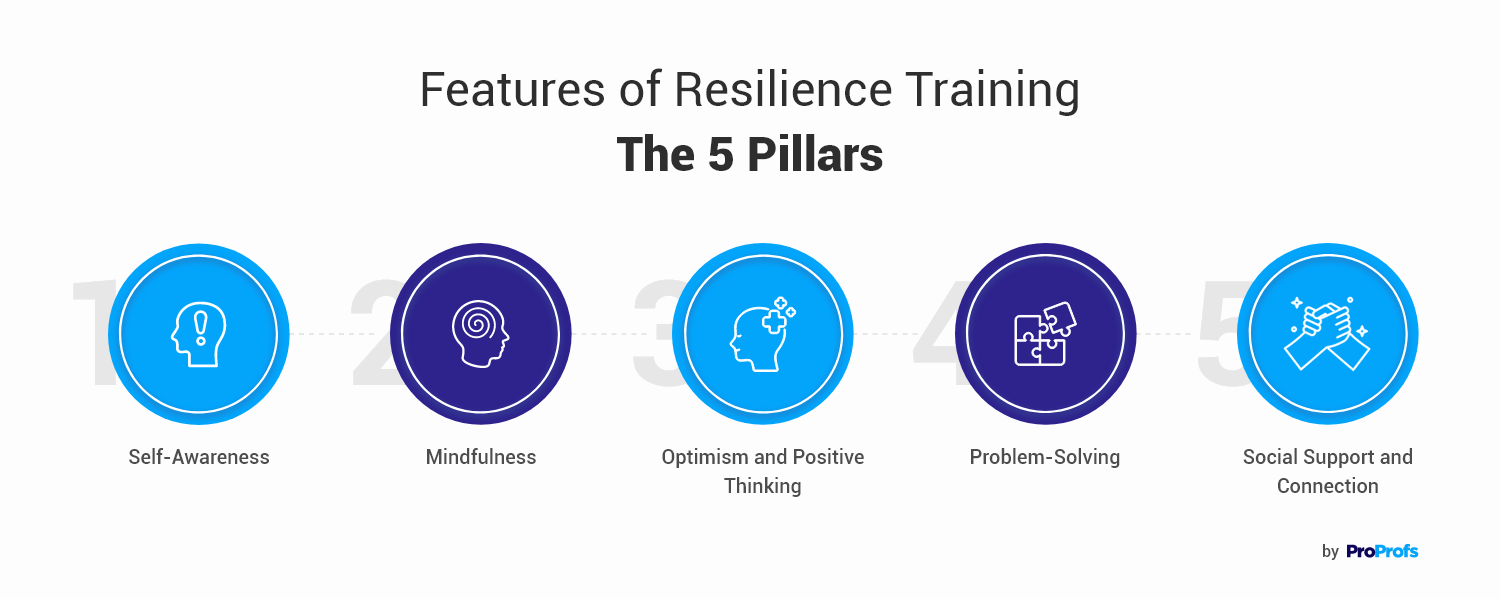Resilience training is vital for building a team of strong employees. If you find it challenging to plan and execute such training, this guide has the answers.
I’ve spent years in the trenches of the training and learning industry, witnessing how employees burn out, lose motivation, and even break down under pressure. That made me think about how we can overcome these difficulties and grow from them.
Based on that experience, here’s my take on administering employee resilience training successfully and other related topics.
What Is Resilience Training in the Workplace?
“It is our attitude toward events, not events themselves, which we can control. Nothing is by its own nature calamitous – even death is terrible only if we fear it.” – Epictetus
Resilience training in the workplace is a training program that equips employees with skills to navigate and bounce back from challenges, stress, and adversity. It focuses on enhancing mental toughness, emotional intelligence, and coping mechanisms.
Employees learn to adapt to change, maintain well-being, and sustain peak performance even in demanding situations through workshops, exercises, and resources.
The goal is to foster a resilient workforce capable of effectively managing stress, maintaining productivity, and promoting a positive work environment.
Why Is Resilience Training Important for Employees?
Employee resilience training is important as it gives your team the capacity to handle the stress and challenges of the modern workplace. It’s about teaching them to stay strong and positive when things get tough.
Research shows that resilience training has quantifiable benefits, such as:
- 83% higher job satisfaction for staff
- 43% less likely to leave
- 1.8 fewer days in sick leave
- 2.1 fewer days lost to presenteeism
Apart from this, there are some other benefits of resistance training.
1. Boosts Productivity and Performance
When employees are stressed and overwhelmed, their productivity plummets.
A study on the economic impact of work-related stress estimated that its cost ranged from U.S. $221 million to over U.S. $187 billion.
A more comprehensive analysis carried out by the American Institute of Stress considered additional factors like absenteeism, turnover, reduced productivity, heightened medical expenses, and increased legal costs. Taking these into account, the total economic impact of stress on U.S. employers was approximated at $300 billion.
Resilience training helps employees manage stress effectively, stay focused, and maintain their motivation despite difficulties. Think laser-sharp focus and consistent output, even during crunch time.
If you are finding it difficult to boost productivity in your workplace, here’s a professional course for you:

2. Reduces Burnout and Absenteeism
The yearly cost of employee absenteeism was reported to be 225.8 billion dollars, which is $1,685/employee/year.
One major reason for this significant financial impact is burnout.
And let me tell you, no one thrives in constant burnout. Resilience training equips employees with healthy coping mechanisms, preventing them from pushing themselves to the edge.
This translates to happier, healthier employees who are less likely to take sick leave or leave the company altogether.
3. Fosters Innovation and Collaboration
When everyone’s feeling stressed, creativity and teamwork take a backseat.
Resilience training for employees fosters a positive and supportive work environment where employees feel comfortable taking risks, sharing ideas, and collaborating effectively. This is where innovation and problem-solving thrive!
4. Builds a Stronger Company Culture
A resilient workforce is a resilient company. When employees know how to handle challenges and setbacks, it creates a culture of trust, support, and adaptability.
Set clear principles for conduct and operations to establish a resilient and sustainable culture built on trust and ethical standards.
This helps create a more positive and productive work environment for everyone.
Investing in resilience training programs is about creating a workforce that can weather any storm, turn challenges into opportunities, and, ultimately, achieve remarkable results.
Features of Resilience Training: The 5 Pillars
The five pillars of resilience in the workplace are a framework for developing mental and emotional strength in the face of professional challenges.

They work together to create a foundation for thriving in dynamic and demanding environments, not just surviving.
1. Self-Awareness
Encourage your employees to enhance their self-awareness by understanding their emotions, thoughts, and reactions to work-related situations.
This pillar emphasizes the importance of self-reflection and emotional management, enabling individuals to effectively leverage their strengths and address weaknesses.
Improved self-awareness contributes to better decision-making and adaptability in workplace challenges.
2. Mindfulness
The ability to be fully present in the moment, without judgment, enables you to focus on the task at hand and manage difficult emotions effectively.
Techniques like meditation, deep breathing, and regular breaks can equip employees with the tools to stay calm under pressure and avoid overthinking.
3. Optimism and Positive Thinking
Foster a culture of optimism and positive thinking among your teams. Encourage employees to reframe negative thoughts, find solutions in challenging situations, and maintain a hopeful perspective through resilience training programs.
This pillar focuses on the importance of cultivating a mindset that views obstacles as opportunities for growth.
4. Problem-Solving
Help your employees develop effective coping skills and problem-solving abilities within your workforce.
Train your employees with practical strategies to manage stress, solve work-related problems, and adapt to changing circumstances.
By enhancing these skills, your teams will be better prepared to navigate complex challenges and contribute to a more proactive and resilient organizational culture.
5. Social Support and Connection
Recognize the significance of social support and connection in the workplace. Promote positive relationships among employees and teams and show the importance of a supportive network.
Encourage collaboration and a sense of belonging, as these social connections can provide emotional support, encouragement, and a shared sense of purpose. A more resilient, connected workforce fosters a collaborative environment that can better navigate business uncertainties.
By strengthening these five pillars, organizations can build a resilient workforce better equipped to handle setbacks, adapt to change, and thrive in demanding situations.
4 Examples of Resilience Training
Here are some examples of employee resilience training:
1. Mindfulness and Stress Management
- Mindfulness exercises: Practicing mindfulness through meditation, breathing techniques, or yoga can help employees manage stress, improve focus, and increase self-awareness.
- Cognitive behavioral therapy (CBT): CBT techniques can help employees identify and challenge negative thought patterns, develop coping mechanisms for stress, and build confidence.
- Positive psychology exercises: Activities like gratitude journaling and visualization can cultivate a positive outlook and boost resilience.
2. Goal Setting and Problem-Solving
- SMART goal setting: Teach employees to set Specific, Measurable, Achievable, Relevant, and Time-bound goals to stay motivated and overcome obstacles.
- Creative problem-solving techniques: Workshops on brainstorming, lateral thinking, and design thinking can equip employees with the skills to tackle challenges from different angles.
- Growth mindset workshops: Encourage employees to embrace challenges as opportunities for learning and growth, fostering a resilient attitude.
3. Communication and Social Support
- Assertive communication training: Develop employees’ ability to communicate effectively and express themselves confidently in challenging situations.

- Team building exercises: Promote collaboration and build trust within teams, creating a supportive environment where individuals can rely on each other for help and encouragement.
- Mentorship programs: Pair experienced employees with younger colleagues to provide guidance and support, fostering a culture of learning and resilience.
4. Leadership Commitment
- Leading by example: Managers and leaders should be role models for resilient behaviors, demonstrating how to handle challenges calmly and effectively.
- Open communication: Encourage employees to openly discuss challenges and setbacks, creating a safe space for vulnerability and learning.
- Work-life balance: Promote healthy work-life boundaries to prevent burnout and ensure employees have time for rest and rejuvenation.
Get Free Employee Training Software — All Features, Forever.
We've helped 567 companies train 200,000+ employees. Create courses in under a minute with our AI LMS or use 200+ ready-made courses on compliance, harassment, DEI, onboarding, and more!
10 Steps to Implement Resilience Training in the Workplace
Issues like lack of employee engagement, time constraints, and unclear strategies often hinder the process of implementing resilience training.
That’s why I want to share the top 10 steps to make your resilience training for employees successful. These steps aim to overcome common hurdles and create a more resilient and thriving work environment.
1. Assess the Needs
Before diving headfirst into a training program, take a step back and understand your employees’ struggles.
Conduct surveys using a focus group to identify their biggest stressors and challenges. This will guide the program’s content and ensure it directly addresses their needs.
2. Secure Leadership Buy-In

Building a resilient workforce starts at the top. Engage your leaders and champion resilience as a core value.
Encourage their participation in training and empower them to model resilient behaviors. Their buy-in fosters a supportive environment where resilience can truly flourish.
3. Design a Tailor-Made Program
Ditch one-size-fits-all solutions! Craft a program that resonates with your employees and addresses their specific needs.
Choose a suitable format like workshops, online modules, or coaching sessions. Then, infuse the content with real-world examples and interactive exercises, ensuring the program is engaging and relevant to their daily lives.
At this point, consider choosing a learning management system (LMS), as it can help you create, manage, deliver, track, and analyze online training programs easily.
4. Focus on the Core Pillars of Resilience
Equip your employees with the tools to bounce back. Choose resilience training courses that teach your employees essential skills like self-awareness, mindfulness, positive thinking, and problem-solving.
Help them build strong social support networks and empower them to seek help when needed. These skills, when honed, become the building blocks of resilience.
5. Make it Practical and Engaging
No more dry lectures! Inject the training with real-world case studies and hands-on activities that allow employees to put their newfound skills into practice.
Make it fun, interactive, and relevant to their work, ensuring they stay engaged and motivated throughout the journey.
Here’s a quick tip to make your training engaging: Add texts, images, videos, presentations, podcasts, brain games, and quizzes.
6. Integrate with Existing Programs
Don’t reinvent the wheel! Weave resilience training into existing initiatives focused on employee well-being.
Combine it with mental health programs, stress management workshops, or even leadership development courses. This holistic approach reinforces the message and creates a cohesive environment for growth.
7. Promote a Culture of Resilience
Fostering a resilient culture is key. Encourage open communication and create a safe space for employees to discuss their challenges without fear of judgment. Recognize and reward resilient behaviors, showcasing them as valuable assets to your organization.
Don’t forget that leadership is vital. Show resilient behaviors to set an example and motivate others.
8. Measure and Track Progress
It’s not just about good intentions. Evaluate the effectiveness of your program through surveys, focus groups, and performance metrics.
Track employee engagement, stress levels, and overall well-being to gauge the impact of your programs. Use this data to refine your programs and ensure they stay on track.
9. Provide Ongoing Support
Resilience is a lifelong journey. Don’t stop at the training. Offer ongoing resources and support, such as coaching or online communities, to help employees continue practicing the skills they learned.
Make self-reflection and personal growth a continuous process.
10. Make it Sustainable
Embed resilience into your organization’s DNA. Integrate it into leadership development programs, company policies, and communication channels.
Make it a core value that permeates every aspect of your workplace culture. This ensures resilience becomes a natural, not just a temporary program.
With these 10 steps, you can cultivate a thriving workplace where resilience is not just encouraged but actively nurtured. Remember, resilience is a powerful tool that empowers individuals and strengthens organizations. By investing in building it, you pave the way for success, adaptability, and lasting well-being in the face of any challenge.
Make Your Employees More Resilient
By following the steps outlined in this blog, you can build a workplace where resilience isn’t just encouraged but woven into the fabric of your culture.
Building the best resilience training for your employees isn’t a one-time program; it’s about forging a culture of resilience.
Focus on building a support system that works for your employees. Encourage open communication, celebrate growth, and empower your team to rely on each other.
Remember, resilience isn’t built overnight, but with every step you take, you create a workforce that can weather any storm and emerge stronger.
 Tips
Tips
We’d love to hear your tips & suggestions on this article!
Get Free Employee Training Software — All Features, Forever.
We've helped 567 companies train 200,000+ employees. Create courses in under a minute with our AI LMS or use 200+ ready-made courses on compliance, harassment, DEI, onboarding, and more!


 We'd love your feedback!
We'd love your feedback! Thanks for your feedback!
Thanks for your feedback!







